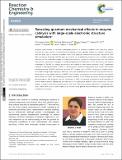Revealing quantum mechanical effects in enzyme catalysis with large-scale electronic structure simulation
Author(s)
Yang, Zhongyue; Mehmood, Rimsha; Wang, Mengyi; Qi, Helena Wen; Steeves, Adam H.; Kulik, Heather Janine; ... Show more Show less
Downloadc8re00213d.pdf (6.381Mb)
PUBLISHER_CC
Publisher with Creative Commons License
Creative Commons Attribution
Terms of use
Metadata
Show full item recordAbstract
Enzymes have evolved to facilitate challenging reactions at ambient conditions with specificity seldom matched by other catalysts. Computational modeling provides valuable insight into catalytic mechanism, and the large size of enzymes mandates multi-scale, quantum mechanical-molecular mechanical (QM/MM) simulations. Although QM/MM plays an essential role in balancing simulation cost to enable sampling with the full QM treatment needed to understand electronic structure in enzyme active sites, the relative importance of these two strategies for understanding enzyme mechanism is not well known. We explore challenges in QM/MM for studying the reactivity and stability of three diverse enzymes: i) Mg[supercript 2+]-dependent catechol O-methyltransferase (COMT), ii) radical enzyme choline trimethylamine lyase (CutC), and iii) DNA methyltransferase (DNMT1), which has structural Zn[superscript 2+] binding sites. In COMT, strong non-covalent interactions lead to long range coupling of electronic structure properties across the active site, but the more isolated nature of the metallocofactor in DNMT1 leads to faster convergence of some properties. We quantify these effects in COMT by computing covariance matrices of by-residue electronic structure properties during dynamics and along the reaction coordinate. In CutC, we observe spontaneous bond cleavage following initiation events, highlighting the importance of sampling and dynamics. We use electronic structure analysis to quantify the relative importance of CHO and OHO non-covalent interactions in imparting reactivity. These three diverse cases enable us to provide some general recommendations regarding QM/MM simulation of enzymes.
Date issued
2018-11Department
Massachusetts Institute of Technology. Department of Chemical Engineering; Massachusetts Institute of Technology. Department of Chemistry; Massachusetts Institute of Technology. Department of Materials Science and EngineeringJournal
Reaction Chemistry & Engineering
Publisher
Royal Society of Chemistry
Citation
Yang, Zhongyue, Rimsha Mehmood, Mengyi Wang, Helena W. Qi, Adam H. Steeves, and Heather J. Kulik. “Revealing Quantum Mechanical Effects in Enzyme Catalysis with Large-Scale Electronic Structure Simulation.” Reaction Chemistry & Engineering (November 2019).
Version: Final published version
ISSN
2058-9883